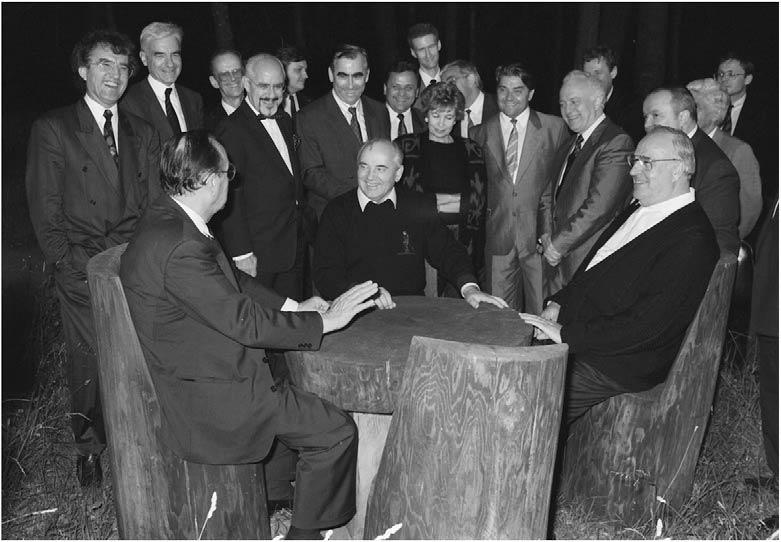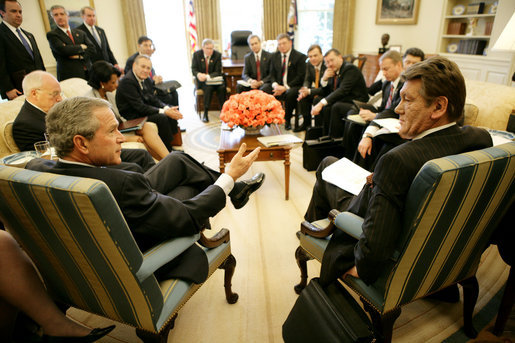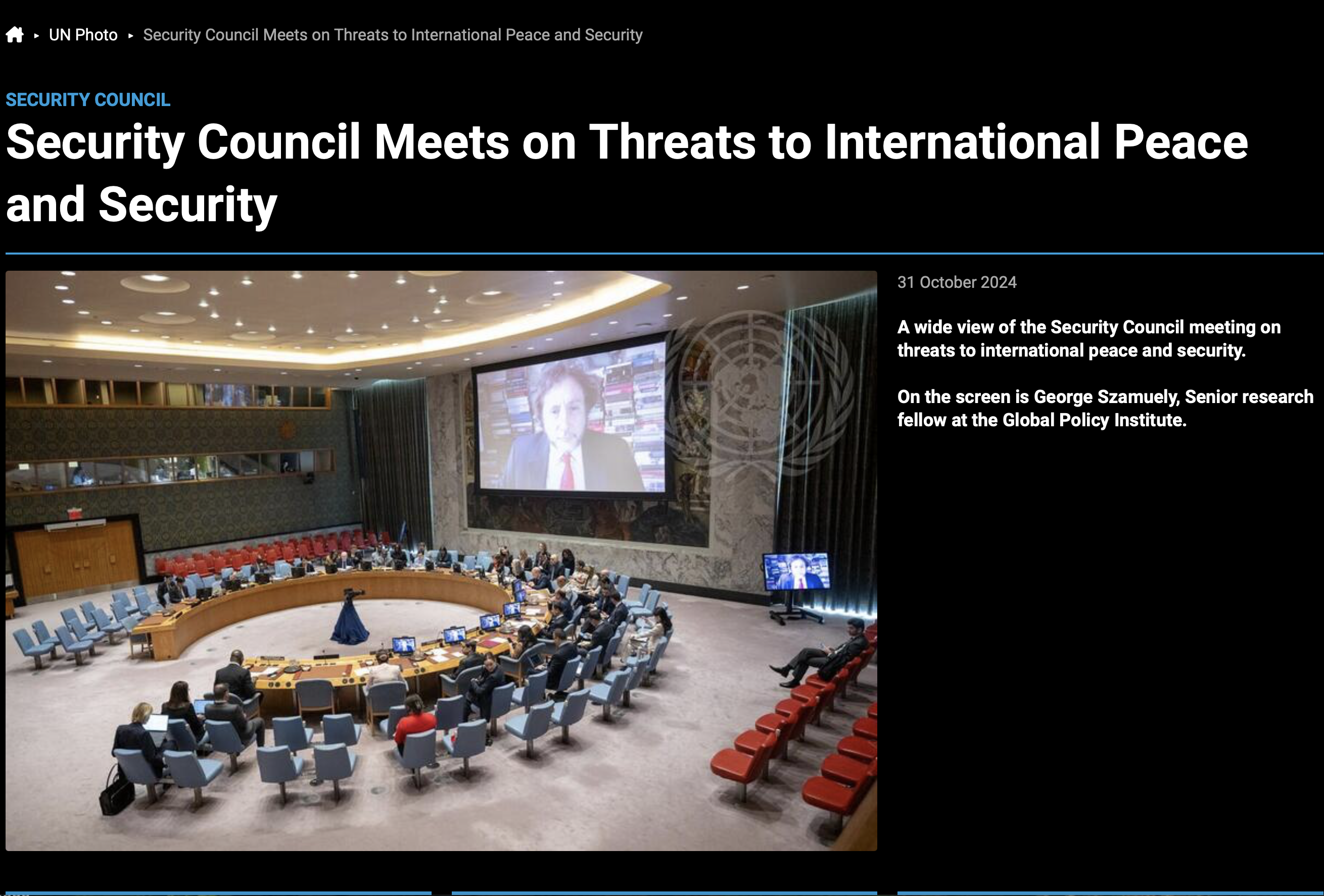U.N. Security Council Meeting on “Threats to International Peace”: The Ukraine War Could have Been Avoided. Address by George Szamuely
 –>
–>
Thank you, Madam President, and thank you for giving me this opportunity to address this distinguished body.
If ever a war could easily have been avoided, the war in Ukraine is that war. If ever a war was needlessly provoked, the war in Ukraine is that war.
The war in Ukraine came about as a result of the Western powers’ single-minded insistence on scooping up every single country on the European continent into NATO, and on expanding the borders of NATO right up to the borders of the Russian Federation.
The war in Ukraine came about because the Western powers for more than three decades continued to dismiss the innumerable pleas of successive Soviet and Russian leaders, including Mikhail Gorbachev, Boris Yeltsin and Vladimir Putin, that there could be no security for anyone on the continent unless the West and Russia agree on a common framework for peace that guarantees the freedom and security of all.
How do we know this? Because former NATO Secretary-General Jens Stoltenberg told us as much. In September 2023, Stoltenberg went before the European Parliament’s Foreign Affairs Committee and explained very succinctly that the war in Ukraine could have been avoided had NATO not insisted on moving its military infrastructure up to Russia’s borders. President Putin, he explained, had
“actually sent a draft treaty that they wanted NATO to sign, to promise no more NATO enlargement….He wanted us to sign that promise, never to enlarge NATO….We rejected that. So he went to war to prevent NATO, more NATO, close to his borders. He has got the exact opposite.”
[embedded content]
What Stoltenberg was referring to here were the two draft proposals for a new security architecture for Europe that Russia had issued on Dec. 17, 2021. The proposals—one addressed to NATO, one addressed to the United States—recalled the framework of the Helsinki Final Act of 1975 in which the mutually antagonistic parties of the Cold War agreed to recognize one another’s security concerns and pledged not to enhance their own security at the expense of that of their purported adversaries.
At the heart of Russia’s proposals was a commitment by NATO to no further expansion, and in particular to no NATO membership for Ukraine. There was nothing so extraordinary about that. In its 1990 Declaration of State Sovereignty, Ukraine had declared “its intention of becoming a permanently neutral state that does not participate in military blocs.”
The notion propagated by NATO spokesmen and Western policymakers that every state has the sovereign right to join any military alliance it wants, to deploy whatever armaments it wants on its territory and to ignore the security concerns of its neighbors flies in the face of innumerable international treaties and covenants, not to mention the international practice of states since time immemorial.
International Covenants and Practice
The Helsinki Final Act of 1975 spoke of the “indivisibility of security.” The 1990 Charter of Paris for a New Europe declared “Security is indivisible and the security of every participating State is inseparably linked to that of all the others.” The OSCE’s 1999 Istanbul Document repeatedly returned to the theme of what it called the “concept of common, comprehensive and indivisible security and a common security space free of dividing lines.”
And let’s not forget of course that in October 1962, the United States did not accept the argument that the island of Cuba had the sovereign right to station on its territory whatever weapons-systems it felt it needed for its security.
However, the security the Western powers demand for themselves they refuse to extend to others, particularly to the Russian Federation.
The Cold War came to an end in 1991. The Soviet Union dissolved the Warsaw Pact, then dissolved itself, then abandoned the Communist ideology that had once generated so much fear and suspicion in the West.
Russia wanted nothing more than to be left in peace to rebuild its shattered economy. Recall Russian President Boris Yeltsin’s words before the joint session of the U.S. Congress on June 17, 1992:
“Today the freedom of America is being upheld in Russia. The idol of communism, which spread everywhere social strife, animosity and unparalleled brutality…has collapsed. It has collapsed never to rise again. I am here to assure you, we will not let it rise again in our land.”
What had taken place at that time was unprecedented in human history. Soviet and Russian leaders gave up territory, gave up military allies and sacrificed security. Recall: They did not have to do this. The Soviet Union had lost no war. To the contrary: The Soviet Union was still a formidable military and political force, inspiring fear and respect throughout the world.
Soviet and Russian leaders did what they did because they believed it to be the right thing to do.
Western Leaders Claim “Cold War Victory”
Yet Western leaders interpreted the end of the Cold War as a victory for the West and a humiliating defeat for the Soviet Union. According to former President George H.W. Bush,
“The Soviet Union did not simply lose the Cold War; the Western democracies won it.”
And, as the supposed victors, the Western powers immediately set about scooping up their winnings. They proceeded to contain, surround and encircle Russia, so that Russia would never again be a Great Power.
Most shocking of all, especially to the Russians, was the speed with which the West did all of this. Let’s recall U.S. Secretary of State James Baker’s words to Mikhail Gorbachev in Moscow on Feb. 9, 1990. The Berlin Wall had fallen only three months earlier, yet the United States was already pushing for a united Germany inside of NATO. To get Gorbachev to agree to this, Baker pledged that NATO would not move “one inch to the East.”
.

Michail Gorbachev discussing German unification with Hans-Dietrich Genscher and Helmut Kohl in Russia, July 15, 1990. Photo: Bundesbildstelle / Presseund Informationsamt der Bundesregierung / source
.
Subsequently, Western politicians were to claim that Baker was referring only to the territory of East Germany, not to the countries of Eastern Europe. But this is a thoroughly disingenuous claim. At the time of Baker’s meeting with Gorbachev, the Warsaw Pact was still in existence, and, since the countries of the Warsaw Pact were all to the east of Germany, the words “not one inch to the East” would have had to be referring to them.
From that moment in February 1990 on, Western leaders were to give Russian leaders repeated assurances that there would be no NATO expansion, only to walk back those assurances the moment they had secured whatever concessions they were seeking from Moscow.
Former U.K. Prime Minister John Major, for example, declared in March 1991 that he “does not foresee circumstances currently or in the future under which the East European countries could be in NATO”.
Then there was former NATO Secretary-General Manfred Wörner who, after having assured a visiting Russian delegation that neither he nor anyone else in NATO was interested in NATO enlargement, was by March 1993 pressing then-U.S. Secretary of State Warren Christopher to “start considering possible timeframes, candidates, and criteria for membership expansion.”
NATO Expansion Moves Swiftly
Once the Western powers embarked on NATO expansion, things moved with extraordinary speed. All that was needed was to tell the Russians that what was actually happening wasn’t really happening, that it was all a figment of their imagination.
For example, President Bill Clinton, after assuring President Yeltsin that the Partnership for Peace program was an alternative to NATO enlargement—and not a preliminary step towards it—immediately went back on his word. In January 1994 in Prague, Clinton declared that, yes, Partnership for Peace was indeed the first step toward NATO membership: “Partnership for Peace,” he said, “is not a permanent holding room.
“It changes the entire NATO dialog so that now the question is no longer whether NATO will take on new members but when and how.” Moreover, even at that early moment Clinton was already indicating that the eventual goal was Ukraine’s induction into NATO.”
In a July 1995 memo written for President Clinton, then-National Security Adviser Anthony Lake boasted that the U.S. intended to ride roughshod over the qualms of some Europeans that NATO enlargement was moving too quickly. Lake boasted “some Allies reacted to Russian criticisms of enlargement by suggesting that the Alliance slow the process. We successfully insisted NATO stick to the timetable.”
Yet, in public, U.S. and NATO leaders were saying something different, something that was manifestly untrue, namely, that NATO expansion was all about ending divisions and bringing stability to Europe. For example, in 1994, Secretary of State Warren Christopher, declared:
“The expansion of NATO will advance America’s fundamental goal — a peaceful, undivided, and democratic Europe. NATO enlargement will enhance stability, reduce tensions, and prevent new dividing lines in Europe.”
U.S. Secretary of State Madeleine Albright proclaimed in February 1997:
“NATO has helped bring within our grasp the most elusive dream of this century: an undivided Europe, at peace, in which every nation is free and every free nation is a partner…. For those not invited to join this year, but who wish to join, NATO’s door must remain open.”
Russia Proposes NATO Membership
But how could there be stability, how could there be no new dividing lines in Europe, if NATO expansion was to be directed toward exclusion of Russia? Russian leaders repeatedly expressed an interest in NATO membership. In a December 1991 letter to NATO leaders, written shortly after the Soviet Union’s dissolution, Boris Yeltsin proposed exploring a framework for Russia’s possible membership in NATO. Yeltsin wrote:
“This will contribute to creating a climate of mutual understanding and trust, strengthening stability and cooperation on the European continent. We consider these relations to be very serious and wish to develop this dialogue in each and every direction, both on the political and military levels. Today we are raising a question of Russia’s membership in NATO, however regarding it as a long-term political aim.”
In 1993, in conversations with U.S. and European leaders, Yeltsin again raised the possibility of Russia’s joining NATO. Yeltsin told NATO Secretary-General Manfred Wörner that Russia might consider NATO membership if the alliance were to become a political organization rather than a military one.
President Putin also spoke of Russia’s interest in NATO membership. In March 2000, asked by BBC presenter Sir David Frost whether Russia could possibly join NATO, Putin replied
“I don’t see why not. I would not rule out such a possibility if and when Russia’s views are taken into account as those of an equal partner.”
[embedded content]
Putin discussed possible NATO membership with President Clinton. Clinton reportedly responded, “I have no objection.” Later on, Clinton told him, “You know, I’ve talked to my team, no, it’s not possible now.”
NATO leaders showed not the slightest interest in exploring these offers of genuine partnership, genuine dissolution of barriers, and genuine frameworks for mutual security.
Kennan’s Warning
That NATO expansion directed toward the exclusion of Russia, toward the containment and encirclement of Russia would end in disaster was obvious to seasoned observers of international affairs. Renowned diplomat and historian George F. Kennan expressed his disgust at this mad rush toward NATO enlargement.
“I think it is the beginning of a new cold war,” he warned in 1998.
“I think the Russians will gradually react quite adversely and it will affect their policies. I think it is a tragic mistake. There was no reason for this whatsoever. No one was threatening anybody else.”
An obvious question arises: What was behind this rush for NATO enlargement? What was the need for it? No one was threatening anybody else. To the contrary: relations between Russia and the West were unprecedented in their conviviality.
Yeltsin cooperated with NATO on Yugoslavia, even working against the interests of Russia’s traditional ally, the Serbs. This cooperation continued with Putin. Putin was the first foreign leader to call Bush after the 9/11 terrorist attacks, and proclaimed that Russia would become America’s partner in the Global War on Terror. Putin permitted the United States to transit troops and weapons across Russian territory en route to Afghanistan.
President Clinton has explained the rationale behind his push to expand NATO. Writing in the April 2022 edition of The Atlantic, Clinton explained that it was all about his fear of Russia’s supposed
“return to ultranationalism, replacing democracy and cooperation with aspirations to empire, like Peter the Great and Catherine the Great…. If Russia chose to revert to ultranationalist imperialism—fueled by natural resources and characterized by a strong authoritarian government with a powerful military—an enlarged NATO and a growing European Union would bolster the continent’s security.”
So there we have it: Nothing here about ending divisions in Europe, about extending security throughout the European continent, and all those other grandiose declarations NATO leaders have regaled us with for the past three decades. It was, as Russian leaders had suspected, all about containing and encircling Russia with a hostile military alliance.
Russian Warnings Ignored
Over the years, Russian leaders have made their feelings plain, but their protests were repeatedly dismissed and ignored. In an interview with the Telegraph in 2008, Former Soviet President Gorbachev said:
“The Americans promised that NATO wouldn’t move beyond the boundaries of Germany after the Cold War but now half of central and eastern Europe are members, so what happened to their promises?”
President Yeltsin repeatedly expressed his bafflement as to why NATO was expanding at breakneck speed to the east, if NATO and Russia were supposed to be partners. In a November 1994 letter to Clinton, Yeltsin warned that the Russian people were increasingly seeing NATO expansion as the “beginning of a new split in Europe.” In December 1994, Yeltsin asked: “Why sow the seeds of mistrust? After all, we are no longer enemies.” In May 1995, in a one-on-one conversation at the Kremlin with Clinton, Yeltsin declared:
“I see nothing but humiliation for Russia if you proceed. How do you think it looks to us if one bloc continues to exist while the Warsaw Pact has been abolished? It’s a new form of encirclement if the one surviving Cold War bloc expands right up to the borders of Russia.”
Moreover, Russian leaders were only too aware that NATO had long set its sights on eventual Ukraine membership. In March 1997 in Helsinki, Clinton disclosed to Yeltsin that, yes, the former republics of the USSR would indeed be joining NATO, and that that would, of course, include Ukraine.
Ukraine’s Turn
From that moment, things moved quickly. May 1997 sees the opening of the official NATO Information and Documentation Center in Kiev; July 1997 sees the signing of a NATO-Ukraine Charter and the establishment of the NATO-Ukraine Commission; November 2002 sees the NATO-Ukraine Action Plan.
Image: American President Bush meeting with Ukrainian President Yushchenko. April 4, 2005 (White House Photo Office)

In April 2005, President George W. Bush and then-Ukraine President Viktor Yushchenko jointly declare:
“The United States supports Ukraine’s NATO aspirations and is prepared to help Ukraine achieve its goals…. The United States supports an offer of an Intensified Dialogue on membership issues with Ukraine.”
April 2008 of course sees the NATO announcement in Bucharest that Ukraine would be a member of NATO. And then, just to take matters up to the present day, we have U.S. Defense Secretary Lloyd Austin announce in October 2021 that the door to NATO membership for Ukraine was open.
As to how the Russians were likely to view Ukraine’s membership in NATO, there is no better source than current CIA Director William Burns. In his 2019 memoir, The Back Channel: A Memoir of American Diplomacy and the Case for Its Renewal, he described how he, as U.S. ambassador to Moscow, wrote an e-mail in 2008 to U.S. Secretary of State Condoleezza Rice, in which he explained:
“Ukrainian entry into NATO is the brightest of all redlines for the Russian elite…. In more than two and a half years of conversations with key Russian players, from knuckle-draggers in the dark recesses of the Kremlin to Putin’s sharpest liberal critics, I have yet to find anyone who views Ukraine in NATO as anything other than a direct challenge to Russian interests.”
Sabotaged Negotiations
That the current war in Ukraine was always about NATO expansion, and not about any seizure of territory was obvious from the arc of the peace negotiations that took place shortly after the start of the conflict—first in Minsk, then in Istanbul.
In April 2022, in Istanbul, Russia and Ukraine reached, and initialed, an agreement, the most important part of which was that Ukraine would pledge to become a “permanently neutral state”: it would never join NATO or allow foreign military bases and contingents on its soil. Ukraine could however seek membership of the European Union.
Crucially, however, Ukraine was not asked to forgo its sovereign claims to Crimea, Donetsk and Luhansk. Those matters were to be resolved in future discussions between the presidents of Russia and Ukraine.
However, this eminently reasonable agreement that would have brought the war to an immediate end was not to the liking of key NATO leaders.
Washington became alarmed that Ukraine was about to agree to this deal. According to the New York Times, U.S. officials told their Ukrainian counterparts, “You understand this is unilateral disarmament, right?”
Finally, U.K. Prime Minister Boris Johnson flew to Kiev and urged Zelensky to drop the idea. Putin was a “war criminal,” Johnson said. He should be crushed, not negotiated with. Even if Ukraine were ready to sign a deal, Johnson told him, the NATO powers were not.
Following the collapse of the talks, Turkey’s foreign minister declared,
“there are those within the NATO member states that want the war to continue…and Russia to get weaker.”
NATO’s policy thus remains unchanged. Despite everything that has happened, despite the experience of the past 30 years, despite the obvious fact that expansion up to Russia’s borders has generated instability and war, despite all of that, what does NATO do? It continues to insist that Ukraine must, and will, be a member of NATO. In other words, the war must go on for the sake of a cause—Ukraine’s membership of NATO—that guarantees war. NATO leaders are like the Bourbons: They have learned nothing and forgotten nothing.
Thank you very much for your time and attention.
George Szamuely,
Senior Research Fellow at the Global Policy Institute
Archive of George Szamuely’s articles on Global Research
*
Click the share button below to email/forward this article to your friends and colleagues. Follow us on Instagram and Twitter and subscribe to our Telegram Channel. Feel free to repost and share widely Global Research articles.
Don’t Miss Out on Global Research Online e-Books!
This was originally published on the author’s Substack.
Featured image source



